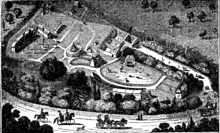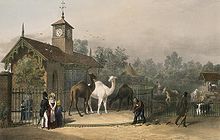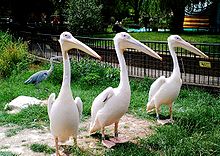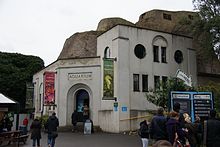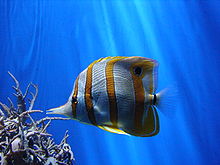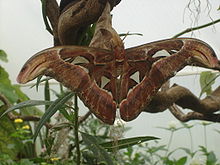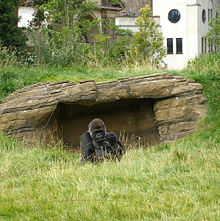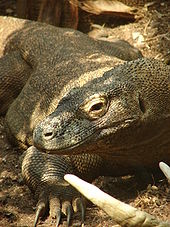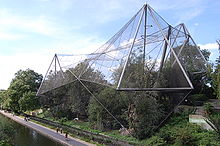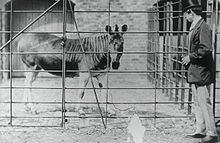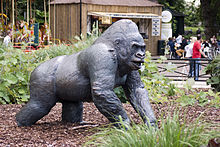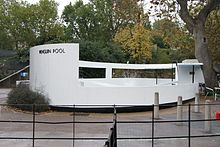- London Zoo
-
ZSL London Zoo 
Date opened 1828 Location Regent's Park, London, England Land area 36 acres (15 ha)[1] Coordinates 51°32′08″N 00°09′21″W / 51.53556°N 0.15583°W Number of animals 16,802 (2006)[2] Number of species 755 (2008)[2] Memberships WAZA,[3] EAZA,[4] BIAZA[5] Major exhibits Gorilla Kingdom, Animal Adventure, Blackburn Pavilion, Clore Rainforest Lookout, Into Africa Website ZSL London Zoo London Zoo is the world's oldest scientific zoo.[6] It was opened in London on 27 April 1828,[7] and was originally intended to be used as a collection for scientific study. It was eventually opened to the public in 1847.[6] Today it houses a collection of 755 species of animals, with 16,802 individuals, making it one of the largest collections in the United Kingdom.[2]
It is managed under the aegis of the Zoological Society of London (established in 1826),[6] and is situated at the northern edge of Regent's Park, on the boundary line between City of Westminster and Camden (the Regent's Canal runs through it).[8] The Society also has a more spacious site at ZSL Whipsnade Zoo in Bedfordshire to which the larger animals such as elephants and rhinos have been moved.[9][10] As well as being the first scientific zoo, ZSL London Zoo also opened the first Reptile house (1849), first public Aquarium (1853),[11] first insect house (1881) and the first children's zoo (1938).
ZSL receives no state funding and relies on 'Fellows', 'Friends', 'Members', entrance fees and sponsorship to generate income.[12][13]
History
ZSL was established by Sir Stamford Raffles and Sir Humphrey Davy in 1826,[6] who obtained the land for the Zoo and saw the plans before Raffles died of apoplexy- a stroke later that year on the 5th of July - his birthday.[13] After his death the third Marquis of Lansdowne took over the project and supervised the building of the first animal houses.[13] The Zoo opened in April 1828 to fellows of the Society,[6] providing access to species such as Arabian oryx, greater kudus, orangutan and the now extinct quagga & thylacine.[13] The Society was granted a Royal Charter in 1829 by King George IV, and in 1847 the Zoo opened to the public to aid funding.[6][14]
It was believed that tropical animals could not survive outside in London's cold weather and so they were all kept indoors until 1902, when Dr Peter Chalmers Mitchell was appointed secretary of the Society.[13] He set about a major reorganisation of the buildings and enclosures of the Zoo, bringing many of the animals out into the open, where many thrived. This was an idea inspired by Hamburg Zoo, and led to newer designs to many of the buildings.[13] Mitchell also envisaged a new 600-acre (240 ha) park to the north of London, and in 1926 Hall Farm, near to Whipsnade village, was bought. In 1931 Whipsnade Wild Animal Park opened, becoming the world's first open zoological park.[6] The first woman to be a curator at the London Zoo was Evelyn Cheesman.
In 1962, 'Caroline', an Arabian oryx, was lent to Phoenix Zoo, Arizona in the world's first international co-operative breeding programme.[6] Today the Zoo participates in breeding programmes for over 130 species.[6]
At the beginning of the 1990s, the Zoo had almost 7,000 animals; the nearest any other collection came to in Britain was Chester Zoo, with just under 3,500 animals. Many of the species in London Zoo could not be seen anywhere else in the country, such as the wombat, Tasmanian devil or long-nosed potoroo.[13]
Although this vast collection was part of the Zoo's appeal, it may also have been one of the main causes of its financial problems.[13] This contributed to the Zoo being faced with closure in the 1980s. Due to the public change of attitude to animals kept in captivity and unsuitably cramped space, the Zoo also suffered dwindling visitor numbers. However, when it was announced that London Zoo would close in 1991, a swell of public support in visitors and donations allowed the Zoo to continue its work, attempt to balance its books, and take on the huge task of restoring its buildings and creating environments more suitable for animal behaviour in the late 20th century.[13][15]
One benefit of the 'swell of public support' was the development of volunteer staff. Employed by both Education and Animal care, these volunteers give one day a week to assist the running of London Zoo and can be recognised by their red sweaters.
Areas and attractions
The Zoo has almost (2011) completed a renovation project aimed at replacing cages with enclosures which recreate animals' natural environments, giving a better lifestyle to the animals, and a more realistic experience to visitors.[16][17] In 2005 the "African Bird Safari"[18] and "Meet The Monkeys"[19] walkthroughs opened and in 2006 "Into Africa"[20] and "Butterfly Paradise"[21] exhibits opened, while in Easter 2007 the Duke of Edinburgh officially opened the new "Gorilla Kingdom"[22] and "Clore Rainforest Lookout" a walkthrough rainforest replacing the small mammals building.[23] During Easter 2008 the Bird House reopened as a tropical rainforest called the "Blackburn Pavilion".[24]
The 'Ambika Paul' Children's Zoo closed in September 2008, and was replaced by the "Animal Adventure" in April 2009.[25]
In the latter half of 2010, the old Parrot House and tearooms - built in the 1860s - along with the penguin pool were demolished to make way for 'Penguin Beach'. The new penguin attraction provides an improved environment for the animals and better public viewing areas, with 'see through' side panels to observe the penguins swimming and diving. Just behind the raised viewing area is a reminder of the parrot house, with the original date (1868) carving atop an ornamental doorway.
Group Number of species Number of animals Mammals 77 310 Birds 113 548 Reptiles 77 309 Amphibians 23 197 Fish 213 5458 Invertebrates 252 8272 Total 755 15104 African Bird Safari
The African Bird Safari opened in Easter 2005 as a redevelopment of the Stork and Ostrich House, replacing three out-of-date enclosures.[18] It is built around a walk-through design 51 metres (167 ft) long and 10 metres (33 ft) high,[18] incorporating a bridge over a stream and high trees.[26]
Species on display include Abdim's stork, superb starlings, Madagascar teals, Von der Decken's hornbills, lilac-breasted roller and blue-bellied roller.[2][18][27]
Animal Adventure
Previously, the Ambika Paul Children's Zoo was based on two sections: the Pet Care Centre and the Paddock. Both provided a hands-on experience aimed at children.[28] At the ZSL AGM in June 2008, it was announced that the Children's Zoo would close in September 2008 to be replaced by 'Animal Adventure' which was opened by the Society's president on 2 April 2009. On opening, it featured animals such as aardvarks, prairie dogs, red pandas, coatis, yellow mongooses, meerkats and porcupines.[29] This on the site of the former Children's Zoo and includes much of the structure of this earlier facility. Red pandas have since been removed from the collection.
Aquarium
There has been an aquarium at the Zoo since 1853 and was the first aquarium to be established in the world.[11] The word 'aquarium' also originates at London Zoo, beforehand the term for a fish enclosure was 'Aquatic Vivarium'.[11] The current aquarium was built in 1921 beneath the Mappin Terraces as the public demand to see the fish increased. In April 1924 King George V with his wife Queen Mary opened the aquarium.
The exhibit is separated into three halls, each home to different types of fish:[30]
- The first hall contains species involved in various conservation projects, such as captive-breeding programmes and other ZSL-based initiatives. These include species such as rudd, European eels, pink sea fans, spiny starfish and seahorses.
- The second hall is a coral reef habitat with tropical species from across the globe, including copperband butterflyfish and clownfish.[2]
- The third hall contains Amazon fish including electric eels, glass knifefish, lungfish and stingray.
The aquarium also includes the Big Fish Tank which holds fish rescued from private homes that had insufficient equipment to look after the fish. This includes catfish, tucunare, tambaqui and pirapitinga.[31] The breeding room is also visible to the public.[30]
Blackburn Pavilion
The Blackburn Pavilion opened to the public on 21 March 2008 as a revamp of the old Bird House.[24] The Victorian building was originally built in 1883 as a Reptile House using funds raised from the sale of Jumbo the elephant to Barnum's Circus. The exhibit is named after the Blackburn family, who provided support to the Zoo during the early 1990s when the Zoo was faced with closure.[24]
Recreating both rainforest and cloud forest environments the pavilion holds more than 50 different species of bird including toucans, starlings, kookaburras, lovebirds, and hummingbirds. The exhibit also contains several species in danger of extinction, or are already extinct in the wild, such as the socorro dove.[24]
Outside the Pavilion is a remarkable clock, installed as part of the refurbishment, which gives an bird-themed display every half hour during the day.
Big Cats
Includes Asian Lions, Sumatran Tigers and Servals.
B.U.G.S
B.U.G.S (Biodiversity Underpinning Global Survival), formerly Web of Life, aims to educate the public on biodiversity itself.[32] Displaying over 140 species, including leaf-cutter ants, Mexican redknee tarantulas, flamboyant flower beetles, anteaters and Malaysian giant stick insects.[32][33] Since 98% of all known animal life are invertebrates the majority of the species on display are also invertebrates.[32]
The building is environmentally friendly, constructed from materials requiring little energy to produce, and generating its heating from visitors' and animals' body heat.[32]
B.U.G.S is also home to ZSLs Invertebrate Conservation Unit, a facility for the breeding of invertebrates.[32]
Butterfly Paradise
The Butterfly Paradise exhibit, launched in May 2006, holds butterfly and moth species from several major regions, including Africa, Southeast Asia, and Central and South America.[21] The species of both fauna and flora have been selected to complement each, with the plants having to provide nectar and breeding areas for the animals.[34]
Species on display include clipper butterfly, great eggfly butterfly, zebra longwing and postman butterfly.[2]
Like much of the Zoo, the exhibit aims to educate the public on conservation projects, such as species recovery programmes, habitat protection initiatives and climate change issues.[21] Alongside the free-flying exhibit there is a pupae breeding room allowing the public to see the development of new butterflies.[35]
Clore Rainforest Lookout
The Clore Rainforest Lookout was opened by Dame Vivien Duffield in May 2007.[22][36] The Lookout replaces the Charles Clore Pavilion for Mammals, which was built in 1967, with the aid of the Clore Duffield Foundation.[37]
The exhibit recreates the South American rainforest and provides canopy and forest floor levels for the public to wander through.[37] Species on display include two-toed sloths, a Southern tamandua, agoutis, silvery marmosets, golden-headed lion tamarins, Goeldi’s monkeys, Geoffroy’s marmosets, pottos, pygmy slow loris, slender loris, emperor tamarins and gentle lemurs.[2][37]
Nightzone, a darkened section, provides an insight into nocturnal rainforest life. This area includes Rodrigues fruit bats, long-nosed potoroos, emperor scorpions and Malagasy giant jumping rats. Recently, London Zoo got a pair of slender lorises who have had their first baby. The happy trio can now be seen in the Nightzone near the back of the part with the Rodrigues fruit bat.[38]
Giants of the Galapagos
Giants of the Galapagos was opened in 2009 and is home to three Galapagos Tortoises: Dirk, Dolly and Dolores. The exhibit features a large indoor house, with heated pond and underfloor heating. A large outdoor paddock has two heated water bodies (one being a naturalistic clay wallow) and has been landscaped to mimic the tortoises natural environment.
Gorilla Kingdom
Gorilla Kingdom is a 6,000-square-metre (65,000 sq ft) exhibit which opened in Easter 2007.[39] It is a 5.3-million pound development that took 18 months to build (funded from the estate of the late Darlene Welch - a zoo volunteer),[40] was officially opened by HRH Duke of Edinburgh on 29 March 2007, and opened to the public on 30 March 2007.[22]
It replaces old monkey enclosures with a giant moated island and indoor gym that is home to a group of western lowland gorillas.[41] There are currently four gorillas in the enclosure:Kesho, a 12-year-old male, Zaire, a 36-year-old female, Effie, a 17-year-old female and Mjukuu, a 12-year-old female[42] brought in from Chessington.[43][44] The area also holds black-and-white colobus monkeys.[22]
The exhibit is also home to Sooty mangabeys, Nile Monitors, a variety of bird species and Diana monkey.[45]
The exhibit was inspired by a conservation project that is managed by ZSL in Gabon.[46][47] It has been planted with plants and herbs that the gorillas can eat while the island itself represents a natural forest clearing in the Central African rainforest.
Visitors to the exhibit learn about the plight of western lowland gorillas in the wild and conservation of rainforests, while being separated from the animals on the island by a moat or a floor to ceiling window.
Bongo Junior, a male silverback known as 'Bobby' to visitors, was found dead on the morning of 5 December 2008 by a keeper. He was one of the most popular animals at the Zoo.[48]
Happy Families
A section wity the small meerkats, oriental small clawed otters and ring-tailed lemurs, animals we see at all the world's zoos.
Into Africa
Into Africa opened on 1 April 2006,[49] and features a high level viewing platform to bring the public face-to-face with the giraffes.[20] Zebras were reintroduced to the Zoo after an 8-year absence, joining the Rothschild giraffe in the main enclosure.[50]
After a survey found that 95% of visitors preferred enclosures without bars, the decision was made to use glass windows instead to bring the public closer to the animals and gain a more intimate experience.[20]
African hunting dogs can be observed through periscopes and observation pods while other species include warthog, okapi and Chapman's zebras.[20][50] In 2009 red river hogs were removed from their enclosure.
Komodo Dragons
The Komodo Dragon enclosure, opened on 12 July 2004 by Sir David Attenborough,[51] mimics a dry river bed with a curving 20-metre (66 ft) glass wall.[52] There is one adult dragon, Raja, and two babies.[53] The Komodo dragons were introduced as part of the European Conservation Breeding Programme.[51][54]
Mappin Terraces
When the Mappin Terraces opened in 1913,[55] it was the first time that members of the public could see animals in an arctic environment.[55][56] In the past it has been home to Polar bears, Ibex and other mountain creatures.
The Mappin Terraces is currently displaying an Australian outback display, home to wallabies and emus and the possibility of expansion in the future.[citation needed]
Meet The Monkeys
Meet The Monkeys is a 1,500-square-metre (16,000 sq ft) enclosure which was opened on 21 March 2005 by Noel Fielding and Julian Barratt, of The Mighty Boosh.[19][57] The exhibit is open, with no roof, and no boundaries between the public and animals.[58] Designed to recreate the Bolivian Rainforest, it holds black-capped squirrel monkeys which are part of the European Conservation Breeding Programme.[59]
The Zoos outer boundary had to be increased to accommodate the new enclosure, encroaching into Regent's Park to the south-east.[59][60]
Outback
A New London Zoo exhibit located near the Aquarium. It includes wallabies and emus.
Penguin Beach
A new exhibit opened 2011 featuring Blackfooted and Rockhopper penguins.
Reptile House
The Reptile House opened in 1927 and was designed by Joan Beauchamp Procter and Sir Edward Guy Dawber.[55] Visitors may notice Reptiles and other animals carved by George Alexander[disambiguation needed
 ] on the front of the building.[55]
] on the front of the building.[55]It is currently home to various reptiles including lizards, tortoises, crocodiles and snakes, adjacent to the house is the Komodo Dragon house (see above).
Round House
Designed by Lubetkin - The Round House opened in 1933, it was first built to accommodate a pair of gorillas, since it has been home to orangutans, macaques, binturong, koalas and a breeding colony of chimpanzees.
The Round House features a unique mechanism which allows the enclosure to rotate to allow the visitors to either view the inside or outside enclosure, for example if the gorillas were outside the guests would view them from the inside quarters vice versa. Since apes left the building the device has not been used for several years.
In 2002, a pair of aye ayes moved into the inside area from Jersey Zoo on breeding loan and since the outside area has been used to hold a male group of ring-tailed lemurs.
Snowdon Aviary
The Snowdon Aviary was designed by Antony Armstrong-Jones, 1st Earl of Snowdon, Cedric Price and Frank Newby, and built in 1964.[55] Arnold Burton was the engineer.
Over the years a variety of birds have been kept in the aviary from birds of prey to waterfowl. The current birds in the aviary include green peafowl, sacred ibis, little egrets, cattle egrets, night herons, waldrapp, ducks, pigeons and African grey-headed gulls.[61]
Zoo World
Built around the Casson Pavilion, originally the old Elephant and Rhino House,[62] Zoo World is now home to bearded pigs, African Porcupines, bactrian camels and also provides a winter home for the pygmy hippos.[63] Previously this house was a temporary home to monkeys and birds while the Clore Rainforest Lookout and Blackburn Pavilion was built.
Inside the house displays inform visitors about the zoo and its various conservation programs.[62]
Others
There are many other animals that are not part of a specific exhibit, these include; gibbons, vultures, tigers, lions, servals, parrots, spider monkeys, penguins (Rockhoppers and Blackfooted), meerkats, otters, lemurs, aye-ayes and Malayan tapirs.
Future developments
Currently the old Parrot house (built 1869) is being demolished to make way for a new penguin pool; the new exhibit is due to open in the summer of 2011 and will have increased viewing area as well as 'underwater windows' to allow visitors to see the birds swimming.
In February 2011, ZSL London Zoo launched its new Tiger S.O.S programme in which it is hoped to raise funds to help save the Sumatran Tiger. The zoo will not only use these funds in extending its three signature projects in Indonesia but build a new Tiger Conservation HQ at the zoo, plus a new exhibit where the tigers can be seen.
These new developments are all part of the new master plan to create better accessibility, which involves relocating the main entrance to the east, adjacent to the Broad Walk in Regent's Park.[64]
Notable animals
Throughout its history the Zoo has had many well-known residents. These may have been scientifically important individuals or simply beloved by the public.
The Zoo was home to the only living quagga ever to be photographed, before the species became extinct in the wild due to hunting in southern Africa in about 1870. Another now extinct species the Zoo held was a number of thylacines, or marsupial wolves.[65]
The first hippopotamus to be seen in Europe since the Roman Empire, and the first in England since prehistoric times, arrived at London Zoo in May 1850 as a gift from the Ottoman Viceroy of Egypt in exchange for some greyhounds and deerhounds. The hippo was named Obaysch and led to a doubling of the Zoo's visitors that year.[66]
In 1865, Jumbo, the largest elephant known at the time, was transferred to the Zoo from Jardin des Plantes in Paris. His name, possibly from Jambo, swahili for hello, became an epithet for anything of large size, such as Boeing's 747 Jumbo jet. He unfortunately became aggressive in old age, and had to stop giving rides; he was sold to Phineas Barnum's circus, the Barnum & Bailey Circus, in 1882, where he was later crushed by a locomotive and killed.[67]
Winnipeg bear (or Winnie) was an American black bear given to the Zoo in 1914 by a Canadian Lieutenant, Harry Colebourn. A. A. Milne visited with his son Christopher Robin, and the boy was so enamoured with the bear Milne wrote the famous series of books for him entitled Winnie-the-Pooh.[65] A 2004 film A Bear Named Winnie is based on the story of Winnie the bear, with Michael Fassbender playing Harry Colebourn.[68]
Guy, a western lowland gorilla, arrived at the Zoo on Guy Fawkes Night (hence the name) 1947 from Paris Zoo, and lived at the Zoo until his death in 1978. Over his 32-year life he became one of the Zoo's best-loved residents.[69] After years of trying to find a mate, in 1969 five-year-old Lomie arrived from Chessington Zoo. They were kept separated for a year to adjust to each other, until they were finally united. Although they got on well together they never produced any offspring.[69] In 1982 Guy was commemorated by a bronze statue, sculptured by William Timyn, in the Zoos Barclay Court.[69]
On 27 November 1949 Brumas became the first polar bear to be successfully bred at the Zoo, and immediately became a major attraction with the public. This led to the Zoo's annual attendance to rise to over 3 million in 1950 - a figure that has yet to be topped. Although a female, the press reported that she was a 'he' and this was not corrected at the time, leading the public to believe the bear was a male.[65] Eighteen years later, on 1 December 1967 the second polar bear bred at the Zoo, this time a male, was born. He was named Pipaluk (Inuit for little one) but, in 1985, had to leave the Zoo when the Mappin Terraces closed.
The Zoo's first giant panda, Chi Chi, arrived in 1958. Although originally destined for an American zoo, Washington had ceased all trade with communist China and so Chi Chi was refused entry to the United States. In the interests of conservation, ZSL had stated they would not encourage the collection of wild pandas. However, when it was pointed out that Chi Chi had already been collected, her purchase was approved, and she immediately become the star attraction at London Zoo. As the only giant panda in the west she was the inspiration of Peter Scott's design for the World Wildlife Fund logo. In July 1972, Chi Chi died and was publicly mourned.[13] The Zoo's last giant panda was Ming Ming. She arrived in 1991 on a breeding loan from China. After unsuccessful breeding attempts with Berlin's Zoo giant panda Bao Bao it had been decided to return Ming Ming to China, leaving the London Zoo without a giant panda since the end of October 1994.
For four days in late August 2005, the Zoo ran an exhibit entitled the Human Zoo, which put eight humans on display in the Mappin Terraces. The idea behind the exhibit was the demonstrate the basic nature of man as an animal and examine the impact we have on the animal kingdom.[70][71]
Today the Zoo holds the only population of humming birds in the United Kingdom in the Blackburn Pavilion.[72]
Architecture
Since its earliest days, the zoo has prided itself on appointing leading architects to design its buildings, today it holds two Grade I, and eight Grade II listed structures.[73]
The initial grounds were laid out in 1828 by Decimus Burton, the Zoo's first official architect from 1826 to 1841, made famous for his work on the Coliseum Theatre and Marble Arch.[13] Burton's work began with the Clock Tower in 1828 above what was then the llama house, which today is the first aid kiosk.[73] In 1830 the East Tunnel, which linked the north and south parts of the zoo together for the first time, was completed, which also acted as a bomb shelter during World War II.[55] Burton concluded his work in 1837 with the Giraffe House, which, due to its functional design, still remains in use as the Zoo's giraffe enclosure in the Into Africa exhibit.[55]
After Burton, Sir Peter Chalmers Mitchell and John James Joass were appointed to design the Mappin Terraces. Completed in 1914, the Mappin Terraces imitates a mountain landscape to provide a naturalistic habitat for bears and other mountain wildlife. In 1933 the Round House, designed by Berthold Lubetkin's Tecton Architectural Group to house gorillas, was one of the first modernist style buildings to be built in Britain. The following year the Penguin Pool, also designed by Tecton, was opened; both are now grade I listed.[74]
The Snowdon Aviary, built in 1964 by Cedric Price, Lord Snowdon and Frank Newby, made pioneering use of aluminium and tension for support. A year later the Casson Pavilion, designed by Sir Hugh Casson and Neville Conder, was opened as an elephant and rhinoceros house.[55]
Filming
Many films and television programmes have made use of London Zoo as a film set.[75]
In 2000,[76] the Burmese python scene from the 2001 film Harry Potter and the Philosopher's Stone was filmed at the Zoo's Reptile House. In the film the inhabitant of the tank is a Burmese python, however in reality it is home to a black mamba. A plaque beside the enclosure commemorates the event.[77]
A couple of scenes were filmed here for the ITV series Primeval. The first was a confrontation between Helen Cutter and Claudia Brown in the old elephant house. The second was a brief scene that showed Abby Maitland with a Komodo Dragon. Although the fictional Wellington Zoo played a large role in the episode, most scenes were filmed at Whipsnade Zoo.[75]
In the "Exploitin" episode of the fifth series of Absolutely Fabulous, Edina and Patsy steal Saffy's new-born infant for a Jean-Paul Gaultier fashion shoot at the Zoo.[75]
In the final scene from the 1987 film Withnail and I a sad Withnail is shown standing in the pouring rain next to the former wolf enclosure, declaiming the speech What a piece of work is a man from Hamlet.[78]
Part of the 1985 film Turtle Diary, based on the novel by Russell Hoban and starring Ben Kingsley and Glenda Jackson, was also filmed here; the film follows a plan to help two of the turtles escape from the Zoo.[79]
The music video for the Talk Talk song "It's My Life" was filmed at London Zoo in 1984. The video was used as a statement against the banality of lip-syncing and includes mostly footage from nature documentaries with shots of lead singer Mark Hollis in the Zoo keeping his mouth shut, obscured by hand-drawn animated lines.
During the 1981 film An American Werewolf in London, the lead character David Kessler (played by David Naughton) woke up naked in the wolves' enclosure. Several other animals are also seen and you can clearly see the old caged enclosures of the tigers and apes.[80]
A scene from the 1964 film The Pumpkin Eater with Anne Bancroft and James Mason was also set at the Zoo.[81]
Transport
The nearest London Underground station is Camden Town on the Northern Line. Baker Street and Regent's Park lie about 1.5 kilometres (0.93 mi) across Regent's Park. The Zoo is served by the 274 bus route.[82]
A regular waterbus service operates along the Regent's Canal from the zoo. Boats depart every hour during the summer months (with a reduced winter service), heading westwards to Little Venice or eastwards towards Camden Lock.
References
- ^ "ZSL Corporate and Private Events". zsl.org. ZSL. http://www.zsl.org/zsl-london-zoo/corporate-and-private-events/. Retrieved 3 March 2008.
- ^ a b c d e f g "ZSL Animal Inventory". ZSL. 31 December 2006. http://www.zsl.org/info/about-us/animal-inventory,649,AR.html. Retrieved 3 March 2008.
- ^ "Zoos and Aquariums of the World". waza.org. World Association of Zoos and Aquariums. http://www.waza.org/en/site/zoos-aquariums. Retrieved 24 November 2010.
- ^ "EAZA Member Zoos & Aquariums". eaza.net. European Association of Zoos and Aquaria. http://www.eaza.net/membership/Pages/Zoos%20and%20Aquariums.aspx. Retrieved 24 November 2010.
- ^ "Find a Zoo". biaza.org.uk. British and Irish Association of Zoos and Aquariums. http://www.biaza.org.uk/public/pages/findazoo. Retrieved 24 November 2010.
- ^ a b c d e f g h i "ZSL's History". ZSL. http://www.zsl.org/info/about-us/zsls-history,129,AR.html. Retrieved 5 March 2008.
- ^ "April 27". Today in Science History. http://www.todayinsci.com/4/4_27.htm. Retrieved 5 March 2008.
- ^ "Google Maps". Google. http://local.google.co.uk/local?f=q&hl=en&q=&ie=UTF8&om=1&z=16&ll=51.534844,-0.15353&spn=0.008502,0.020127&t=k. Retrieved 5 March 2008.
- ^ "London elephants to join friends at Whipsnade". ZSL. 30 October 2001. http://www.zsl.org/info/media/press-releases/796,796,PR.html. Retrieved 5 March 2008.
- ^ "Elephants leave London". BBC News. 1 November 2001. http://news.bbc.co.uk/1/hi/england/1631128.stm. Retrieved 5 March 2008.
- ^ a b c "The History of the Aquarium". ZSL. http://www.zsl.org/zsl-london-zoo/exhibits/aquarium/the-history-of-the-aquarium,656,AR.html. Retrieved 6 March 2008.
- ^ "Volunteering at London Zoo and Whipsnade Wild Animal Park" (PDF). ZSL. Archived from the original on 11 April 2008. http://web.archive.org/web/20080411152620/http://static.zsl.org/files/volunteering-at-london-zoo-and-whipsnade-wild-animal-park-116.pdf. Retrieved 5 March 2008.
- ^ a b c d e f g h i j k "London Zoo". Good Zoos. http://www.goodzoos.com/UK%20Zoos/london.htm. Retrieved 5 March 2008.
- ^ "London Zoo". Places to Go. http://www.places-to-go.org.uk/London_Zoo.htm. Retrieved 11 March 2008.
- ^ "It could be Zoo...". ZSL. 4 October 2007. http://www.zsl.org/info/media/press-releases/null,1867,PR.html. Retrieved 5 March 2008.
- ^ "London Zoo in London, United Kingdom". TravelGator. http://www.travelgator.com/do/attractionDesc?id=3631. Retrieved 5 March 2008.[dead link]
- ^ "New vision announced for London Zoo". ZSL. 18 July 2005. http://www.zsl.org/zsl-london-zoo/news/new-environmental-vision-announced-for-london-zoo,169,NS.html. Retrieved 5 March 2008.
- ^ a b c d "African Bird Sarafi". ZSL. http://www.zsl.org/zsl-london-zoo//whats-on/african-bird-safari,285,AR.html. Retrieved 5 March 2008.
- ^ a b "Meet the Monkeys is a Huge Success". ZSL. 6 April 2005. http://www.zsl.org/zsl-london-zoo/news/meet-the-monkeys-is-a-huge-success,131,NS.html. Retrieved 5 March 2008.
- ^ a b c d "Come eye-to-eye with a Giraffe". ZSL. 31 March 2006. http://www.zsl.org/info/media/press-releases/null,1808,PR.html. Retrieved 5 March 2008.
- ^ a b c "Butterfly Paradise". ZSL. http://www.zsl.org/zsl-london-zoo/exhibits/butterfly-paradise/butterfly-paradise,744,AR.html. Retrieved 5 March 2008.
- ^ a b c d "New Gorillas get the Royal Treatment". ZSL. 29 March 2007. http://www.zsl.org/zsl-london-zoo/news/new-gorillas-get-the-royal-treatment,350,NS.html. Retrieved 5 March 2008.
- ^ "Animals to get taste of freedom". BBC News. 15 July 2005. http://news.bbc.co.uk/1/hi/england/london/4693027.stm. Retrieved 3 March 2008.
- ^ a b c d "Blackburn Pavilion". ZSL. http://www.zsl.org/zsl-london-zoo/exhibits/blackburn-pavilion/blackburn-pavilion,850,AR.html. Retrieved 3 March 2008.
- ^ Animal Adventure - our new children's zoo ZSL London Zoo
- ^ "ZSL London Zoo". Evan Evan Tours. http://www.evanevanstours.co.uk/london-zoo.htm. Retrieved 6 March 2008.
- ^ "Pitter Patter of Webbed Feet at ZSL London Zoo". ZSL. http://www.zsl.org/zsl-london-zoo/news/pitter-patter-of-webbed-feet-at-london-zoo,259,NS.html. Retrieved 6 March 2008.
- ^ "Children's Zoo". ZSL. http://www.zsl.org/zsl-london-zoo/whats-on/childrens-zoo,123,EV.html. Retrieved 6 March 2008.
- ^ "2007/2008 Annual Report" (PDF). ZSL. 17 June 2008. http://static.zsl.org/files/annualreport-smalld-f-538.pdf. Retrieved 30 June 2008.
- ^ a b "Aquarium uncovered". ZSL. http://www.zsl.org/zsl-london-zoo/exhibits/aquarium/aquarium-uncovered,721,AR.html. Retrieved 6 March 2008.
- ^ "Big Fish Tank". ZSL. http://www.zsl.org/zsl-london-zoo/exhibits/aquarium/big-fish-tank,662,AR.html. Retrieved 6 March 2008.
- ^ a b c d e "Catch up with the B.U.G.S!". ZSL. http://www.zsl.org/zsl-london-zoo/whats-on/catch-up-with-the-b-u-g-s,122,EV.html. Retrieved 6 March 2008.
- ^ "The Longest Insect in the World". ZSL. 13 August 2004. http://www.zsl.org/zsl-london-zoo/news/the-longest-insect-in-the-world,36,NS.html. Retrieved 6 March 2008.
- ^ "Planting in Paradise". ZSL. http://www.zsl.org/zsl-london-zoo/exhibits/butterfly-paradise/planting-in-paradise,754,AR.html. Retrieved 6 March 2008.
- ^ "Pupae Breeding Room". ZSL. http://www.zsl.org/zsl-london-zoo/exhibits/butterfly-paradise/pupae-and-breeding-room,746,AR.html. Retrieved 6 March 2008.
- ^ "Clore Rainforest Lookout". ZSL. http://www.zsl.org/zsl-london-zoo/exhibits/clore-rainforest-lookout/. Retrieved 6 March 2008.
- ^ a b c "About the Clore Rainforest Lookout". ZSL. http://www.zsl.org/zsl-london-zoo/exhibits/clore-rainforest-lookout/about-the-clore-rainforest-lookout,634,AR.html. Retrieved 6 March 2008.
- ^ "Nightzone". ZSL. http://www.zsl.org/zsl-london-zoo/exhibits/clore-rainforest-lookout/nightzone,633,AR.html. Retrieved 6 March 2008.
- ^ Elliott, Valerie (30 March 2007). "Three’s company on gorilla love island". London: Times Online. http://www.timesonline.co.uk/tol/news/uk/article1588944.ece. Retrieved 3 March 2008.
- ^ "Gorilla Kingdom". ZSL. http://www.zsl.org/zsl-london-zoo/exhibits/gorilla-kingdom/. Retrieved 3 March 2008.
- ^ "New home for urban gorillas". BBC News. 29 March 2007. http://news.bbc.co.uk/1/hi/uk/6507747.stm. Retrieved 3 March 2008.
- ^ "1531 Mjukuu". James R. Davis Gorilla Studbook (Gorilla Haven). 7 May 2008. http://www.gorilla-haven.org/jrdavis-gorilla-studbook/1531.htm. Retrieved 8 May 2008.
- ^ "Meet the gorillas". ZSL. http://www.zsl.org/zsl-london-zoo/exhibits/gorilla-kingdom/meet-the-gorillas,30,PS.html. Retrieved 3 March 2008.
- ^ "'Gorilla kingdom' opens in London". BBC News. 28 March 2008. http://news.bbc.co.uk/1/hi/sci/tech/6499593.stm. Retrieved 3 March 2008.
- ^ "About Gorilla Kingdom". ZSL. http://www.zsl.org/zsl-london-zoo/exhibits/gorilla-kingdom/about-gorilla-kingdom,599,AR.html. Retrieved 28 January 2011.
- ^ "Gorilla Conservation". ZSL. http://www.zsl.org/zsl-london-zoo/exhibits/gorilla-kingdom/gorilla-conservation,608,AR.html. Retrieved 3 March 2008.
- ^ "Bushmeat & forests conservation". ZSL. http://www.zsl.org/field-conservation/bushmeat-and-forest/. Retrieved 3 March 2008.
- ^ London Zoo's gorilla Bobby dies BBC News, 5 December 2008
- ^ "Malcolm Fitzpatrick, Curator of Mammals". ZSL. http://www.zsl.org/discovery-learning/meet-the-team/meet-the-keeper-malcolm-fitzpatrick-curator-of-mammals,371,AR.html. Retrieved 7 March 2008.
- ^ a b "Into Africa". ZSL. http://www.zsl.org/zsl-london-zoo/whats-on/into-africa,133,EV.html. Retrieved 3 March 2008.
- ^ a b "Komodo Dragons Arrive". ZSL. 2 August 2004. http://www.zsl.org/zsl-london-zoo/news/komodo-dragons-arrive,41,NS.html. Retrieved 7 March 2008.
- ^ "Komodo Dragons". ZSL. http://www.zsl.org/zsl-london-zoo/whats-on/komodo-dragons-at-london-zoo,125,EV.html. Retrieved 3 March 2008.
- ^ "Four new dragons for St George". ZSL. http://www.zsl.org/zsl-london-zoo/news/four-new-dragons-for-st-george,256,NS.html. Retrieved 7 March 2008.
- ^ "Komodo dragon conservation in Indonesia". ZSL. http://www.zsl.org/field-conservation/island-ecosystems/komodo-dragon-conservation-in-indonesia,294,AR.html. Retrieved 7 March 2008.
- ^ a b c d e f g h "ZSL Architecture". ZSL. http://www.zsl.org/info/about-us/zoo-architecture,103,AR.html. Retrieved 6 March 2008.
- ^ "London Zoo, in Regent's Park". London Drum. http://www.londondrum.com/cityguide/london-zoo.php. Retrieved 13 March 2008.
- ^ "Meet the Monkeys Walkthrough". ZSL. http://www.zsl.org/zsl-london-zoo/exhibits/meet-the-monkeys-walkthrough,792,AR.html. Retrieved 7 March 2008.
- ^ "A revolutionary new monkey walkthrough at London Zoo". ZSL. http://www.zsl.org/zsl-london-zoo/news/a-revolutionary-new-monkey-walk-through-at-london-zoo,113,NS.html. Retrieved 7 March 2008.
- ^ a b "Meet the Monkeys". ZSL. http://www.zsl.org/zsl-london-zoo/whats-on/meet-the-monkeys,126,EV.html. Retrieved 7 March 2008.
- ^ "Visitor Information". ZSL. http://www.zsl.org/zsl-london-zoo/visit/. Retrieved 7 March 2008.
- ^ "Snowdon Aviary - London Zoo". ZSL. http://www.zsl.org/london-zoo/news/animals-at-the-zoo,61,NS.html. Retrieved 6 March 2008.
- ^ a b "Zoo World/Casson Pavilion". About.com. http://golondon.about.com/od/londonzoo/ig/London-Zoo-Photos/Zoo-World.htm. Retrieved 13 March 2008.
- ^ "London Zoo Map". ZSL. https://static.zsl.org/images/originals/london-zoo-map-february-200-1088.jpg. Retrieved 13 March 2008.
- ^ "London Zoo Masterplan". Terry Farrell and Partners. Archived from the original on 4 February 2008. http://web.archive.org/web/20080204191933/http://www.terryfarrell.co.uk/projects/relaxing/relax_londonZoo.html. Retrieved 11 March 2008.
- ^ a b c "Famous animals". ZSL. http://www.zsl.org/discovery-learning//zoo-world/famous-animals,98,AR.html. Retrieved 5 March 2008.
- ^ "Obaysch the Hippo". Andrew Cusack. 24 December 2007. http://www.andrewcusack.com/blog/2007/12/obaysch_the_hippo.php. Retrieved 5 March 2008.[dead link]
- ^ "London Zoo". Victorian London. http://www.victorianlondon.org/entertainment/londonzoo.htm. Retrieved 5 March 2008.
- ^ "A Bear Named Winnie". IMDb. http://www.imdb.com/title/tt0437088/. Retrieved 27 March 2008.
- ^ a b c "Guy the Gorilla: A Life Remembered". ZSL. http://www.zsl.org/zsl-london-zoo/news/guy-the-gorilla-a-life-remembered,409,NS.html. Retrieved 5 March 2008.
- ^ "Humans strip bare for zoo exhibit". BBC News. 25 August 2005. http://news.bbc.co.uk/1/hi/england/london/4184466.stm. Retrieved 3 March 2008.
- ^ "The Human Zoo". ZSL. 17 August 2005. http://www.zsl.org/zsl-london-zoo/news/the-human-zoo,180,NS.html. Retrieved 3 March 2008.
- ^ "London Zoo's new bird enclosure". BBC News. 20 March 2008. http://news.bbc.co.uk/1/hi/england/london/7306169.stm. Retrieved 27 March 2008.
- ^ a b "Architecture at the Zoo". ZSL. 15 June 2006. http://www.zsl.org/zsl-london-zoo/news/architecture-at-the-zoo,271,NS.html. Retrieved 5 March 2008.
- ^ "Berthold Lubetkin". Design Museum. http://www.designmuseum.org/design/berthold-lubetkin. Retrieved 26 March 2008.
- ^ a b c "Commercial Filming and Photography". ZSL. http://www.zsl.org/info/corporate/commercial-filming-photography-and-unit-base-car-parking,579,AR.html. Retrieved 5 March 2008.
- ^ "Potter set news & pics". IGN. 15 November 2000. http://uk.movies.ign.com/articles/034/034135p1.html. Retrieved 28 March 2008.
- ^ "Filming locations for Harry Potter and the Philosopher's Stone". Movie Locations. http://www.movie-locations.com/movies/h/harry_potter1.html. Retrieved 5 March 2008.
- ^ Jack Malvern (20 October 2007). "They’re back for one more bender: Withnail and I get together again". London: Times Online. http://entertainment.timesonline.co.uk/tol/arts_and_entertainment/film/london_film_festival/article2697992.ece. Retrieved 5 March 2008.
- ^ "Turtle Diary (1985): Filming Locations". IMDb. http://www.imdb.com/title/tt0090219/locations. Retrieved 5 March 2008.
- ^ "An American Werewolf in London (1981): Trivia". IMDb. http://www.imdb.com/title/tt0082010/trivia. Retrieved 5 March 2008.
- ^ "To the London Zoo!". Travel Guide London. 31 December 2007. http://www.travelguidelondon.co.uk/places-and-tourist-sites/to-the-london-zoo.html. Retrieved 5 March 2008.[dead link]
- ^ "How to find us". ZSL. http://www.zsl.org/zsl-london-zoo/visit/how-to-find-us,125,AR.html. Retrieved 5 March 2008.
External links
- London Zoo website Official website
- Zoological Society of London website
- ZSL Annual Review
- ZSL Bushmeat and Forest Conservation
- London Zoo in the 19th Century
- London Zoo at British Zoos
Zoological Society of London Zoos and aquariums - Biota!
- London Zoo
- Whipsnade Zoo
Research - Fellows of ZSL
- Website
Zoological Gardens in the United Kingdom Those listed in italics contain more than 5000 animalsZoos - Africa Alive!
- Amazon World Zoo
- Banham Zoo
- Belfast Zoo
- Birdland Park and Gardens
- Birmingham Nature Centre
- Blackbrook Zoological Park
- Blackpool Zoo
- Borth Animalarium
- Bristol Zoo
- Chester Zoo
- Chessington World of Adventures
- Colchester Zoo
- Cotswold Wildlife Park
- Dartmoor Zoological Park
- Drusillas Zoo Park
- Drayton Manor Theme Park
- Dudley Zoo
- Edinburgh Zoo
- Exmoor Zoo
- Flamingo Land Theme Park and Zoo
- Folly Farm Adventure Park and Zoo
- Hamerton Zoo
- Howletts Wild Animal Park
- International Centre for Birds of Prey
- Isle of Wight Zoo
- Lakeland Wildlife Oasis
- London Zoo
- Marwell Wildlife
- Monkey World
- Newquay Zoo
- Noah's Ark Zoo Farm
- Paignton Zoo
- Paradise Park, Cornwall
- Paradise Wildlife Park
- Rare Species Conservation Centre
- South Lakes Wild Animal Park
- Tropical World at Roundhay Park
- Twycross Zoo
- Welsh Mountain Zoo
- Whipsnade Zoo
Safari parks Permanently closed Zoos, aquariums, and aviaries Types of zoos Conservation Lists Animals Other topics - Animals in captivity
- Animal training
- Behavioral enrichment
- Captive breeding
- Frozen zoo
- Immersion exhibit
- Nocturnal house
- Wildlife conservation
- Zookeeper
- Zoology
- Portal
- Project
- Category
- Commons
Categories:- Cultural and educational buildings in London
- Zoos in England
- Visitor attractions in London
- Buildings and structures in Westminster
- 1828 establishments in England
- Grade I listed buildings in London
- Grade II* listed buildings in London
- Grade II listed buildings in London
- Grade I listed zoo buildings
- Visitor attractions in Westminster
- Regent's Park
Wikimedia Foundation. 2010.

